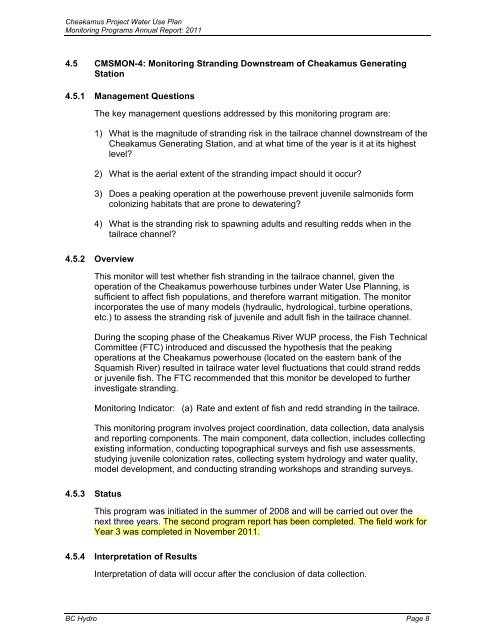Cheakamus Project Water Use Plan Monitoring ... - BC Hydro
Cheakamus Project Water Use Plan Monitoring ... - BC Hydro
Cheakamus Project Water Use Plan Monitoring ... - BC Hydro
You also want an ePaper? Increase the reach of your titles
YUMPU automatically turns print PDFs into web optimized ePapers that Google loves.
<strong>Cheakamus</strong> <strong>Project</strong> <strong>Water</strong> <strong>Use</strong> <strong>Plan</strong><br />
<strong>Monitoring</strong> Programs Annual Report: 2011<br />
4.5 CMSMON-4: <strong>Monitoring</strong> Stranding Downstream of <strong>Cheakamus</strong> Generating<br />
Station<br />
4.5.1 Management Questions<br />
The key management questions addressed by this monitoring program are:<br />
1) What is the magnitude of stranding risk in the tailrace channel downstream of the<br />
<strong>Cheakamus</strong> Generating Station, and at what time of the year is it at its highest<br />
level?<br />
2) What is the aerial extent of the stranding impact should it occur?<br />
3) Does a peaking operation at the powerhouse prevent juvenile salmonids form<br />
colonizing habitats that are prone to dewatering?<br />
4) What is the stranding risk to spawning adults and resulting redds when in the<br />
tailrace channel?<br />
4.5.2 Overview<br />
This monitor will test whether fish stranding in the tailrace channel, given the<br />
operation of the <strong>Cheakamus</strong> powerhouse turbines under <strong>Water</strong> <strong>Use</strong> <strong>Plan</strong>ning, is<br />
sufficient to affect fish populations, and therefore warrant mitigation. The monitor<br />
incorporates the use of many models (hydraulic, hydrological, turbine operations,<br />
etc.) to assess the stranding risk of juvenile and adult fish in the tailrace channel.<br />
During the scoping phase of the <strong>Cheakamus</strong> River WUP process, the Fish Technical<br />
Committee (FTC) introduced and discussed the hypothesis that the peaking<br />
operations at the <strong>Cheakamus</strong> powerhouse (located on the eastern bank of the<br />
Squamish River) resulted in tailrace water level fluctuations that could strand redds<br />
or juvenile fish. The FTC recommended that this monitor be developed to further<br />
investigate stranding.<br />
<strong>Monitoring</strong> Indicator: (a) Rate and extent of fish and redd stranding in the tailrace.<br />
This monitoring program involves project coordination, data collection, data analysis<br />
and reporting components. The main component, data collection, includes collecting<br />
existing information, conducting topographical surveys and fish use assessments,<br />
studying juvenile colonization rates, collecting system hydrology and water quality,<br />
model development, and conducting stranding workshops and stranding surveys.<br />
4.5.3 Status<br />
This program was initiated in the summer of 2008 and will be carried out over the<br />
next three years. The second program report has been completed. The field work for<br />
Year 3 was completed in November 2011.<br />
4.5.4 Interpretation of Results<br />
Interpretation of data will occur after the conclusion of data collection.<br />
<strong>BC</strong> <strong>Hydro</strong> Page 8

















